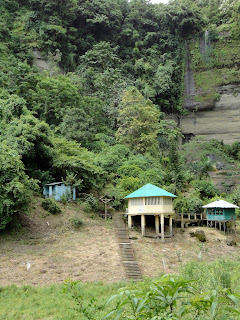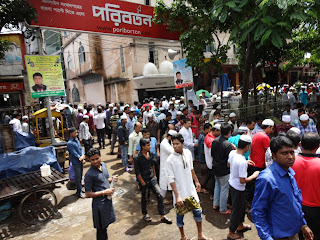07/09/13
I was originally mildly disappointed to be going to Dhaka
instead of Kolkata for the summer. Kolkata, a city in India, is the other major
location in which one might choose to study Bangla. It is known for its history
of leftist intellectuals and continues to be seen as a vibrant artistic and
cultural destination. Playwrights like Utpal Dutt and Rabindranath Tagore are
associated with the city (and if you are a theater person and you don’t know
who they are, you should find out, because they are both excellent), and I was also
looking forward to visiting Jana Sanskriti, a group near Kolkata that practices
Augusto Boal’s “Theatre of the Oppressed” techniques. My knowledge of what
Dhaka was and is known for was horribly inadequate (we’ll get to that, I promise),
but what I had heard was that it was one of the most crowded and overpopulated
cities in the world (and it was friendly and good for learning Bangla). To
drive the point home, the students studying Bangla in Kolkata this summer
through the other program I could have done are all humanities students. Here,
there are two of us in a group of fourteen. And while I have already noted how
diverse my group’s interests are, the majority of them are studying public
health and development in one way or another.
Which
is all lead up to my admitting how very ignorant I was. I should have realized
that a city as large and crowded as Dhaka has the kind of vibrant arts scene
that big cities all over the world encourage. But I didn’t. Here is the day in
which I realized how wrong I was:
 |
| This is Liz. Liz is my adventure buddy. In this photo, she is drinking coconut juice. Directly from a coconut. Like you do. |
It was scorchingly hot when Liz and I left to meet my LP at
the Shawra Railgate. We were going to take a public bus for the first time,
which was both exciting and terrifying. When we got on the bus, it looked like
an extremely run-down version of a Greyhound bus, with torn and faded seat
covers and a half-shattered windshield. There were six rows of seating that were only for women and the
rest of the bus was full of men. We stood with my LP, clutching the seats to
keep from falling as the bus jerked and weaved its way through traffic. Though
the bus was hot, as long as we were moving, there was a breeze that made it
tolerable. Luckily, it was also one of the buses that actually stopped, instead
of slowing down slightly while you jump off (left foot first so you don’t fall
under the wheels as you exit).
 |
| Maybe you can't tell, but this was the most crowded market ever. |
When we stepped down at Chandni
Chowk (a huge indoor/outdoor market for women’s clothing) I could not believe
the size of the crowd. Once we stepped into the flow of people, we had no
choice but to move along with them. It was less like walking and more like being
a part of a river’s current. I am not a person who is prone to claustrophobia,
but the first thing I found myself thinking was, “I would be completely screwed
if there was a fire. As would everyone in this market.” Luckily, I was quickly
distracted and overstimulated by the number of people, fabrics, accessories and
ornaments surrounding me (this would come back to bite me later in the day when
I realized how extremely dehydrated I had allowed myself to become). Eventually,
we were able to fight our way out of the current of the main crowd and into a
side eddy where we could actually stop to look at cloth.
 |
| This is how you shop for clothes here. Point at a fabric. Check it out. Get enough of one you like and take it to a tailor. Design the outfit with your tailor. He makes it. All for about $20/outfit. This is an overwhelming amount of fabrics to choose from. In case you didn't notice. |
There were hundreds of tiny shops piled
floor to ceiling with fabrics in as many colors and prints as you can imagine.
There were cottons and silks and linens and blends. There were merchants whose
eyes lit up at the sight of foreigners who might pay them more and merchants
who entirely ignored us. Anytime one of us saw a fabric we liked, we would
stop, point and ask to see it unfolded from the stack. If it seemed worth it,
we would then have a conversation about price with the shopkeeper. Once a price
was agreed on, the fabric would be handed to us and we would be off to match it
to fabric for pants or leggings and an orna/dupatta (basically a scarf you wear
draped across your chest for modesty). If we were lucky, the fabric would come
in a pre-matched three-piece set. Sometimes, though, it’s fun to make up your
own fabric combinations. I, for instance, purchased a black fabric printed with
tiny dogs, hearts, and arrows, to which I then added a hot pink and gold yoke (a
yoke is a flowery, lacy chest piece that gets sewn onto the fabric) and matched
with hot pink pants and a gauzy, hot pink scarf. In Bangladesh, any color goes
with any other color; there is no such thing as tacky, and I absolutely love
it.
 |
| Remember I told you about pani puri? This is a pani puri cart. Yum! |
A quick side-on Bangladeshi clothes
shopping (AKA beginner’s fashion design): After you buy the fabric, you take it
to a tailor and describe exactly how you want it to be cut for your salwar
kameez suit: neckline shape, piping, sleeve length, decorations, top length,
pant-type. For people who are new to working with a tailor, this many decisions
can be overwhelming, but for me there’s something really enjoyable about being
so hands-on in what my clothes will look like. It does, however, mean that
getting a new salwar kameez made can take forever; people rarely buy readymade
garments here (why would you when they are more expensive and less well-fitted
to your unique shape?).
 |
| This is Bobby. Bobby is a screenprinter, and those are her prints. |
From Chandni Chowk, we headed for
Dhanmoondi, a young, artsy neighborhood full of galleries and restaurants. There,
we visited an art gallery called Dhaka Art Center where the screenprints,
etchings, and sketches of one artist, Biren Shome, were being displayed
downstairs and an Oxfam poster contest for defeating world hunger was opening
upstairs. The screenprints were stunning. Done mostly in black and white, they
depicted women’s faces and upper bodies in a style that felt strikingly unique
but still Bangladeshi. Non-western visual arts tend to be treated as either
derivative of western masters or primitively native (which I find detestable),
but it is also true in every artistic field that the influence of colonization
on cultural practices cannot be ignored. The “West” was here and lingers still
in the most random places. I thought Shome’s work had just the slightest touch
of Picasso, but for me this didn’t detract from his originality in technique,
style, and theme. While we were visiting the gallery, we got to meet some
younger men and women who are aspiring artists. They were working on their own
pieces in the back, and their generosity in sharing their techniques and their
work with us was incredible. We may even go back to take a class with them in
screenprinting! One of the women, Bobby, gifted me with one of her own
screenprints (and her phone number so that we can hang out and talk about art
again sometime).
Dhanmoondi is home to many other
art galleries, which I hope I have time to explore over the course of this
program. I’m still working on tapping into the theater scene, because I have no
doubt that I am going to find a lot of quirky and inspiring people there.






























